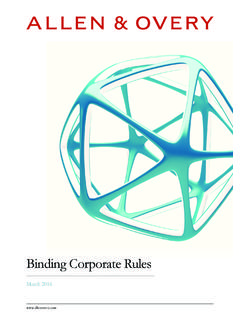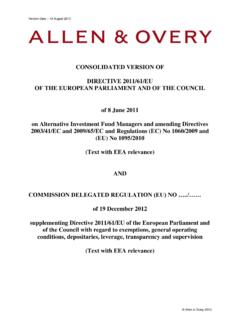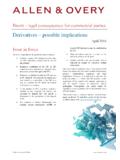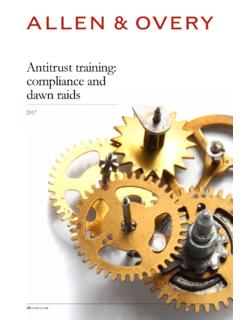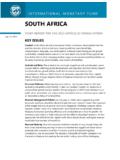Transcription of Capital Requirements Directive IV Framework Credit ...
1 Capital Requirements Directive IV Framework Credit Valuation Adjustment (CVA). Allen & Overy Client Briefing Paper 10 | January 2014. 2 CRD IV Framework : Credit Valuation Adjustment (CVA) | January 2014. CRD IV Framework : Credit Valuation Adjustment (CVA). This briefing paper is part of a series of briefings on relevant to the in-house lawyer. This briefing is for the implementation of Basel III in Europe via the general guidance only and does not constitute Capital Requirements Directive IV1 (CRD IV) and definitive advice. the Capital Requirements Regulation2 (CRR), replacing the Banking Consolidation Directive3 and NOTE: In relation to the topics discussed in the Capital Adequacy The legislation is this briefing, the CRR contains a number of highly complex: these briefings are intended to discretions for member states in relation to provide a high-level overview of the architecture of national implementation.
2 The regime may the regulatory Capital and liquidity Framework and therefore differ across member states in a to draw attention to the legal issues likely to be number of respects. 1 2013/36/EU. This briefing paper is based on information 2 Regulation 575/2013. 3 2006/48/EU. available as at 17 January 2014. 4 2006/49/EU. Background and Scope Sources The global financial crisis has prompted legislators and CRR (Regulation 575/2013): Recital (83); Part Three: regulators to introduce reforms and strengthen existing Article 92(3)(d), Article 162(2)(h), Article 273(6), Title legislation to address perceived weaknesses in VI (Articles 381-386), Part Nine: Article 456(2), derivatives markets. These reforms include a number Article 457(h) and, Part Ten: Article 482.
3 Of measures aimed at reducing counterparty Credit risk including more robust back-testing and stress testing, UK Financial Conduct Authority (FCA) Policy the requirement for certain derivatives contracts to be Statement (PS13/10) CRD IV for Investment Firms cleared through a central counterparty (CCP), (December 2013) (the FCA Policy Statement). increased Capital Requirements and, to the extent derivatives contracts are not cleared, increased UK Prudential Regulation Authority (PRA) Policy collateral and even higher Capital Requirements (thus Statement (PS7/13) Strengthening Capital standards: incentivising central counterparty clearing). This implementing CRD IV, feedback and final rules briefing paper will focus on Capital Requirements and, (December 2013) (the PRA Policy Statement).
4 In particular, the new Requirements in respect of CVA. risk. PRA Supervisory Statement (SS12/13) Counterparty Credit risk (December 2013) (the PRA Supervisory Statement). Allen & Overy LLP 2014. 3 CRD IV Framework : Credit Valuation Adjustment (CVA) | January 2014. Introduction Previously, the Basel II regulatory Capital regime deterioration of Credit quality at times of market addressed the risk of counterparty default in respect stress and pro-cyclicality. of derivatives transactions but did not address CVA. In Europe, CVA risk is addressed in the CRR. risk and, thus, failed in some cases to capture the risk of mark-to-market losses resulting from a although it differs in some significant respects to deterioration in the creditworthiness of the Basel III proposals.
5 The European CVA regime counterparties to derivatives transactions. This led took effect from 1 January 2014 and applies to to a number of institutions not holding adequate Credit institutions and investment firms entering Capital to cover CVA losses during the financial into uncleared OTC derivatives transactions and crisis, and indeed, mark-to-market losses being a securities financing transactions which are not greater source of losses than those arising from subject to an exemption. outright defaults .5. It is worth noting that, in respect of uncleared Consequently, as part of the drive to make sure all derivatives transactions, the European Market underlying, material risks are addressed in the Infrastructure Regulation (EMIR)6 also requires Capital regime, Basel III sought to strengthen the financial counterparties to hold an appropriate and global counterparty Credit risk Framework by, proportionate amount of Capital to manage the risk amongst other things, increasing the risk weights of not covered by appropriate exchange of collateral 7.
6 Counterparty Credit exposures relating to derivatives it is expected that this requirement will be satisfied transactions entered into with financial institutions by compliance with the It is, however, (although these will be lower in respect of cleared unclear how financial counterparties (as defined in transactions) and introducing Requirements for EMIR) will be expected to comply with their EMIR. institutions to set aside regulatory Capital to cover Capital obligations to the extent they are not subject CVA risk (in addition to counterparty default risk). to the CRR (ie they are not institutions). The measures target financial institutions specifically as they are perceived as being the most sensitive to systemic risk due to the sheer volume of derivatives exposures concentrated within a 6 Regulation (EU) No 648/2012 of the European Parliament and of the relatively small number of counterparties which Council on OTC derivatives, central counterparties and trade repositories dated 4 July 2012.
7 Could, as it did in 2008, lead to a simultaneous 7 See Article 11(4) EMIR. 8 See Joint ESMA/EIOPA/EBA Discussion Paper on Technical 5 See BCBS: Basel III: A global regulatory Framework for more resilient banks Standards on Risk Mitigation Techiques for Uncleared OTC. and banking systems dated June 2011 at Section A, paragraph 2(14)(b). Derivatives dated 6 March 2012. What is CVA risk? CVA risk is the risk of loss caused by changes in the to the institution .9 It has also been described as Credit spread of a counterparty due to changes in its the difference between the hypothetical' value of Credit quality. CVA is an adjustment to the mid- the derivative transaction assuming a risk-free market valuation of the portfolio of transactions counterparty and the true value of the derivative with a counterparty which reflects the current transaction that takes into account the possibility of market value of the Credit risk of the counterparty changes in creditworthiness of the counterparty 9 See Article 381 (Meaning of Credit Valuation Adjustment) CRR.
8 Allen & Overy LLP 2014. 4 CRD IV: Credit valuation adjustment (CVA) | January 2014. (including the possibility of the counterparty's during times of market stress when markets are default) .10 The purpose of CVA is to quantify the more volatile, so that counterparties can ensure that risk that counterparties to derivatives transactions transactions are correctly valued for accounting may be more or less creditworthy at any given time purposes and appropriate regulatory Capital is set during the life of a transaction because this will aside to protect against the risk of insolvency arising affect the value of the transaction to the from such losses. counterparties. It is, therefore, an important component in valuing derivatives.
9 It is imperative The calculation of CVA takes into account certain that this value is as accurate as possible, particularly counterparty Credit risk mitigants such as netting and collateral arrangements and certain offsetting 10 See EC consultation on counterparty Credit risk frequently asked hedges and seeks to cover any risk that is left after questions (MEMO/11/77) dated 9 February 2011. these other mitigants have been factored in. Scope Under the CRR, Credit institutions and investment (ii) transactions with non-financial counterparties14. firms are required to hold additional own funds due which do not exceed the clearing threshold' as to CVA risk arising from OTC derivatives (other defined in EMIR15 (known as NFC-s).)
10 Than Credit derivatives used for Credit risk mitigation regardless of whether such counterparties are (CRM)11 purposes) and, if CVA risk exposures are established in the EU or in a third country - this material, securities financing effectively includes all undertakings other than financial counterparties16 and CCPs;17 18. However, exemptions are available in respect of: (iii) intra-group transactions (subject to national (i) transactions cleared through a CCP (including laws requiring the structural separation of a transactions with a qualifying CCP and banking group);19. transactions between a client and a clearing member when the clearing member acts as an (iv) transactions with pension scheme intermediary between the client and the arrangements20 (until the transitional provisions relevant CCP);13 in EMIR cease to apply);21.
